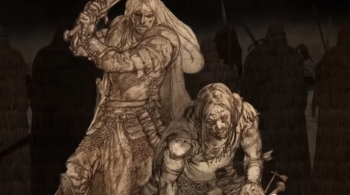Andals
The Andals are one of the three major ethnic groups from which the humans of Westeros descend, the others being the First Men and the Rhoynar. The Andal invasion caused the fall of many of the kingdoms of the First Men which had developed in the wake of the Pact with the children of the forest. The Andals also brought the Faith of the Seven to the Seven Kingdoms. The Lord of the Seven Kingdoms, the king on the Iron Throne, claims to be the King of the Andals, the Rhoynar, and the First Men.[1]
The Dothraki refer to Westeros as Rhaesh Andahli, the land of the Andals.[2] Ser Jorah Mormont, a northman, is called "The Andal" in Essos,[3] even though the Andal influence is less in the north of Westeros.[4]
History
Andals in Essos
The Andals were a tall and fair-haired people[5][6] said to have originated in the Axe of northern Essos,[7] although some say they came from south of the Silver Sea.[8] They migrated and established Andalos in northwestern Essos, stretching south as far as the Flatlands and the Velvet Hills and engaging in conflict with the tribes that inhabited those lands, such as the so-called "hairy men".[7] Legend tells that they were visited by the incarnations of the Seven, who crowned their first king, Hugor of the Hill.[9] They learned the art of working iron from the Rhoynar who lived along the Rhoyne.[9]
It is unknown when the Andals sailed west across the narrow sea from Andalos to Westeros; some sources date the Andal invasion to six thousand years ago.[10] According to the True History, it occurred four thousand years ago, and some maesters claim it was only two thousand years ago.[11]
Maesters generally believe that the Andals fled because of the expanding Valyrian Freehold.[7] The Valyrians established Myr in place of a walled Andal town,[12] and many of the Valyrian colonists of Pentos intermarried with local Andals.[13] Archmaester Perestan suggests that Norvos was originally founded by Andals.[14] Before the Scouring of Lorath by Valyrian dragonlords, the Lorathi isles were ruled by Qarlon the Great, who desired to be King of All Andals.[15]
Andals in Westeros
Andals first landed in the Fingers and attacked the First Men living in the Vale. They burnt out the weirwood groves, hacked down the faces and slaughtered the children of the forest that they came across. Everywhere they proclaimed the triumph of the Seven over the old gods. A hill, now known to the Westerosi as High Heart, was sacred to the children of the forest. There, the Andal king Erreg the Kinslayer cut down the children’s grove of thirty-one weirwoods.[16] It is said that the First Men killed half of the children of the forest with bronze blades, and the Andals finished the job with iron.[17]
After several hundred years of war, the Andals conquered or married into the southern kingdoms of the First Men and created their own. Only the Kings of Winter resisted the Andals successfully, stopping them at Moat Cailin.[5][7]
According to legend, at some point in time at the Nightfort, the Rat Cook served an Andal king, possibly Tywell II Lannister or Oswell I Arryn, a pie made of bacon and, unknown to the king, the king's son.
Culture
Andal culture is marked by the strong influences it has had on the culture of the Seven Kingdoms. The Andals brought the Faith of the Seven to Westeros and with it the warrior tradition of the knight. The Andals used iron, while the First Men used bronze. The Andals also brought a superior writing system that supplanted the First Men's runes.
Almost all of the early history of Westeros was written after the Andal invasions, causing it to have an Andal perspective.[18] Ancient Andal warriors painted and carved seven-pointed stars on their flesh.[5][19] They also carved stars into the stones of the Fingers when they first arrived in Westeros, although this practice declined as they expanded beyond the Vale.[7]
Despite their victory, the Andals were outnumbered by the native First Men of Westeros. The early Andal kings often tolerated worship of the old gods in godswoods to prevent religious turmoil,[7] although the Faith of the Seven came to dominate southern Westeros over time. According to George R. R. Martin, hardly any Westerosi are pure Andal or First Man after thousands of years of interbreeding.[20]
References
- ↑ A Game of Thrones, Chapter 1, Bran I.
- ↑ A Game of Thrones, Chapter 3, Daenerys I.
- ↑ A Game of Thrones, Chapter 64, Daenerys VIII.
- ↑ The World of Ice & Fire, The North.
- ↑ 5.0 5.1 5.2 A Game of Thrones, Chapter 66, Bran VII.
- ↑ The World of Ice & Fire, Ancient History: Valyria's Children.
- ↑ 7.0 7.1 7.2 7.3 7.4 7.5 The World of Ice & Fire, Ancient History: The Arrival of the Andals.
- ↑ The World of Ice & Fire, Beyond the Free Cities: The Grasslands.
- ↑ 9.0 9.1 A Dance with Dragons, Chapter 5, Tyrion II.
- ↑ A Game of Thrones: d20-based Open Gaming RPG.
- ↑ A Dance with Dragons, Chapter 48, Jaime I.
- ↑ The World of Ice & Fire, The Free Cities: The Quarrelsome Daughters: Myr, Lys, and Tyrosh.
- ↑ The World of Ice & Fire, The Free Cities: Pentos.
- ↑ The World of Ice & Fire, The Free Cities: Norvos.
- ↑ The World of Ice & Fire, The Free Cities: Lorath.
- ↑ A Storm of Swords, Chapter 22, Arya IV.
- ↑ A Dance with Dragons, Chapter 33, Tyrion VIII.
- ↑ A Feast for Crows, Chapter 5, Samwell I.
- ↑ A Feast for Crows, Chapter 4, Brienne I.
- ↑ So Spake Martin: Event Horizon Chat, March 18, 1999
| ||||||||||||||||||||||||||||||||||||||||||||||||||||||||||

